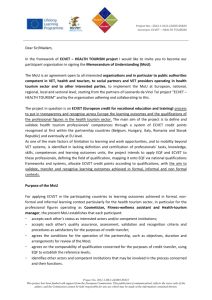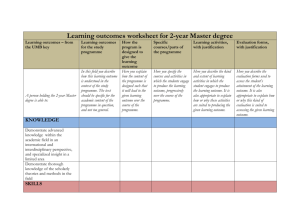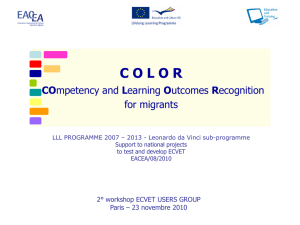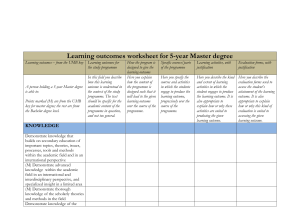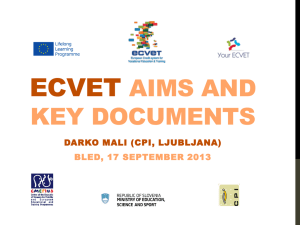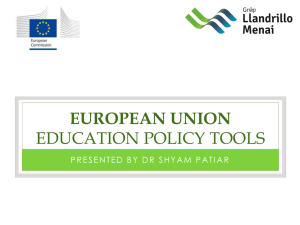ECVET - ANPCDEFP
advertisement
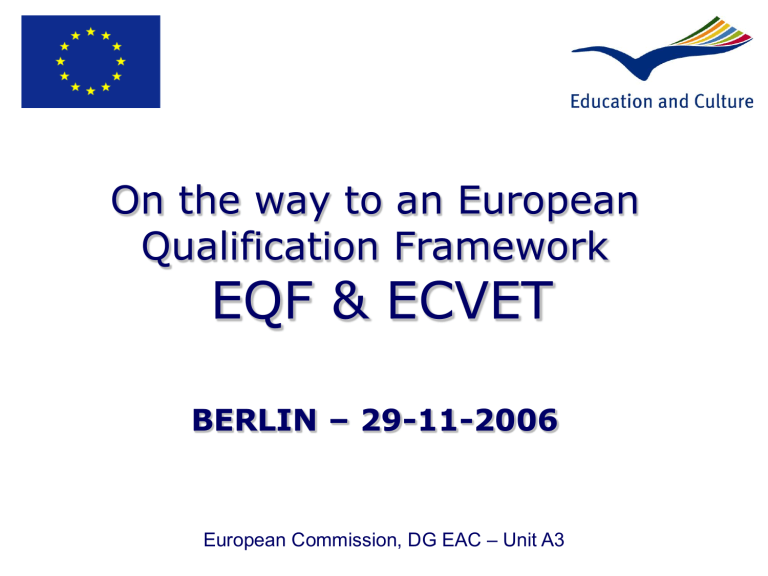
On the way to an European Qualification Framework EQF & ECVET BERLIN – 29-11-2006 European Commission, DG EAC – Unit A3 Why an EQF? 2 Problem Lack of communication and cooperation between education and training systems Barriers to lifelong learning and mobility Between Member States and between systems, e.g. between higher education and VET, between international sectors and national systems 3 Existing instruments Europass: description of an individual’s qualifications, so far without indication of levels Bologna process: Higher Education framework Directive 2005/36 for access to regulated professions 4 EQF: approach and objectives Increase transparency and portability of qualifications Create common reference framework as translation device between qualification systems and levels Cover all levels and forms of learning Look at learning outcomes 5 Why Learning outcomes? 6 Learning outcomes shifts focus from input to what a person knows and is able to do better match between needs of the labour market and education and training provision facilitates transfer and use of qualifications across different countries and education and training systems facilitates validation of non-formal and informal learning 7 Using EQF 8 Country A Q Q Q Q 9 NQ F/ NQ S NQ F/ NQ S NQ F/ NQ S NQ F/ NQ S Country B EQF Level 8 EQF Level 7 EQF Level 6 EQF Level 5 EQF Level 4 NQ F/ NQ S NQ F/ NQ S Q Q EQF Level 3 EQF Level 2 EQF Level 1 NQ F/ NQ S Q Swedish postsecondary engineering education (Påbygnadsutbildning) = EQF Level 4 = Irish post secondary education at national level 6 (Advanced certificate) E Q F Subsidiarity voluntary does not replace national systems or describe specific qualifications qualifications placed via national system EQF: recommends that MS 1. Use EQF as a reference tool 2. Reference their levels to EQF by 2009 3. Reference new qualifications to EQF levels by 2011 4. Use learning outcomes approach 5. Designate national EQF centre EQF: Commission’s role Support MSs in cooperation, testing and guidance Establish EQF advisory group Report after 5yrs with possible review of Recommendation EQF reference level descriptors Based on learning outcomes (knowledge, skills and competence) and not systems 8 levels covering all levels of academic and vocational qualifications Integrates Bologna descriptors (within learning outcomes of levels 5-8) Where do we stand? Discussion in Council and EP Aim: Agreement under German presidency 2007 Leonardo da Vinci projects: test and develop EQF; develop national/sectoral frameworks Who benefits? Main users will be qualification bodies Individuals and employers benefit because EQF Facilitates reading across systems Facilitates diverse learning pathways and access to lifelong learning Facilitates mobility for working or learning Why ECVET? 17 ECVET is a political priority 18 ECVET will improve mobility 19 ECVET is a priority for lifelong learning 20 ECVET will improve transparency of qualifications 21 ECVET will improve mutual trust and cooperation 22 ECVET and EQF 23 Complementarities between ECVET and EQF Based on learning outcomes Centred on qualifications Emphasis on Lifelong Learning Focused on Mobility Transparency oriented 24 Complementarities between ECVET and EQF ECVET 8 COMMON REFERENCE LEVELS 25 Why is ECVET important for individuals? 26 Learning context B Learning context A Mr X has an opportunity for a learning period abroad 27 Achieved learning outcomes Learning context B Learning context A Mr an opportunity MrXXhas achieves L.O. for a learning period abroad 28 Learning context B Learning context A …and now Mr X wants to transfer “home” his new learning outcomes to include them for the qualification Achieved L.O. 29 Learning context B Learning context A Transfer Process Achieved L.O. 30 Learning context B Learning context A But it’s difficult, because of barriers… 31 • No transparency But it’s difficult, • No mutual because of barriers… trust • No validation • No accumulation of learning outcomes • No recognition 32 ECVET would help remove those barriers 33 Learning context B Learning context A Because competent body A validates and recognises learning outcomes achieved in context B ECVET would mean Mr X can transfer “home” his new L.O. Achieved L.O. 34 Qualification context (A) Context A Qualification — The learning outcomes gained are accumulated and are now an integrated part of his qualification 35 What is ECVET? 36 37 Credit points Units Transfer process 38 Credit points Units Transfer process Learning context B Learning context A Transcript of record Assessment of L.O. Credit for L.O. 39 Validation of L.O. Recognition of L.O. Accumulation of L.O. 40 Credit points Units Transfer process The aim of the ECVET learning outcomes transfer process 41 A qualification is described in units of learning outcomes Knowledge Unit Skills Competence 42 Qualification The heart of ECVET: Units 43 The heart of ECVET: Units Qualification Unit Unit Unit 44 Designed at national level by competent bodies. 45 Credit points Units Transfer process 80 Pts 46 Qualification ECVET Credit points indicate the relative weight of units: an example Unit 10 Points Unit 50 Points Unit 20 Points Allocation of ECVET credit points To a qualification then to units Different approaches are possible Convention in the formal context 47 What is the role of the ‘competent bodies’? 48 Linking qualifications to ECVET: the role of the ‘competent bodies’ Commitment for linking qualifications to ECVET and decision on the adoption Design for processes: assessment, validation, transfer, accumulation and recognition Expression of Qualifications and units Allocation of Credit Points Establishment of partnerships/memoranda of understanding Regulation and quality assurance 49 Using ECVET: ‘Competent bodies’ and VET providers are involved in: 50 Individual’s learning agreement Assessment of learning outcomes Award of credits Validation Transfer Recognition … Roadmap towards ECVET 51 ECVET: procedure for 2006-2007 Launch the consultation (November 2006 March 2007)* Conference in Germany June 2007 Preparation of the final proposal Adoption process Implementation in Member States *Consultation document on: http://ec.europa.eu/dgs/education_culture/consult/index_en.htm 52 l
